UK drive: Fiat's 500L remains a left-field choice
Fiat’s facelift 500L has arrived in the UK. Tom Wiltshire finds out what it’s like.
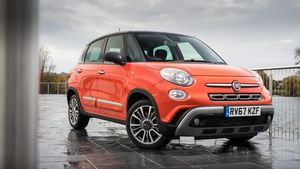
What is it?
The biggest member of Fiat’s 500 brand, the 500L is aimed at buyers who like the cutesy style and Italian flair of the 500 city car – but can’t cope with its tiny boot, three-door body and barely-there rear seat.
Despite the modern image, it’s a member of a class that’s quickly becoming old-fashioned – the mini-MPV. To combat this frumpy association, Fiat’s heavily pushing the connection with both the stylish 500 and the more rugged 500X – turning the 500L into a ‘crossover-crossover’ of sorts.
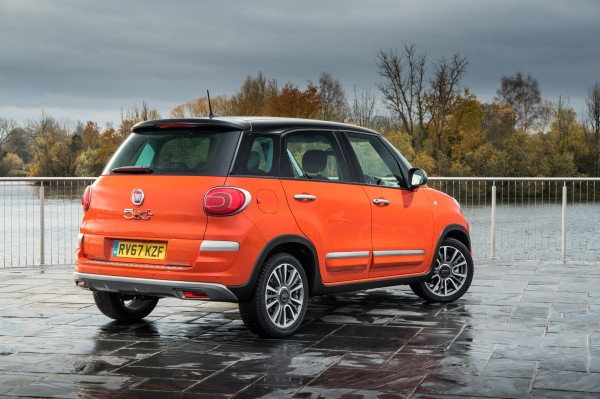
What’s new?
Fiat has made many minor tweaks on the outside of the car, but fundamentally little has changed from the car’s previous iterations – in Urban trim, at least. Go for a more rugged Cross model though, and you’ll get new satin chrome scuff plates front and rear, a grille motif pinched from the 500X, and black plastic cladding on the wheelarches.
Inside, there have been bigger changes. There’s a new steering wheel inspired by the 124 Spider, updated dials with a larger colour screen in the middle and a larger 7-inch Uconnect touchscreen.
Responding to feedback about the previous model’s ergonomics, Fiat has raised the gearshift so it’s easier to reach and adjusted the climate control dials so they’re more visible. It’s also replaced the ‘computer-mouse’ handbrake of the old car with a conventional item.
Finally, the ‘MPW’ variant, which adds a bigger boot and two optional rear seats, has been renamed ‘Wagon’.
What’s under the bonnet?
It used to be possible to spec the 500L with a two-cylinder TwinAir petrol engine, but Fiat’s simplified the range. Now, there’s a choice of just four – two 1.4-litre petrols and 1.3 or 1.6-litre diesels.
The lower-powered 1.4 petrol and 1.3 diesel make do with 95bhp – though if you plan on using the car’s capacious load capacity to its fullest, you’d be better off with the 1.6-diesel or higher-powered 1.4 petrol, both with 120bhp. None of the engines feel fast, though.
The diesel’s superior pulling power makes it the engine of choice for families. It’s also very efficient, with claimed economy of 67.8mpg even in its higher-powered tune. It’s noisy, though, and feels old-fashioned thanks to a lumpy power delivery and decidedly agricultural note.
For refinement, you’re better off with the petrol engine – though with economy of just 42.8mpg, you’ll pay the price at the pumps.
It’s also worth noting if you want an automatic gearbox, you’re limited to just the 1.3-litre diesel, which is matched to either a five-speed manual or five-speed ‘Easytronic’ automatic. The rest of the cars get six-speed manuals as standard. Fiat’s raised the gearbox to bring the shifter closer to hand in a bid to improve ergonomics, though sadly it doesn’t improve the gearshift itself – it’s loose, imprecise, and not very pleasant to use.
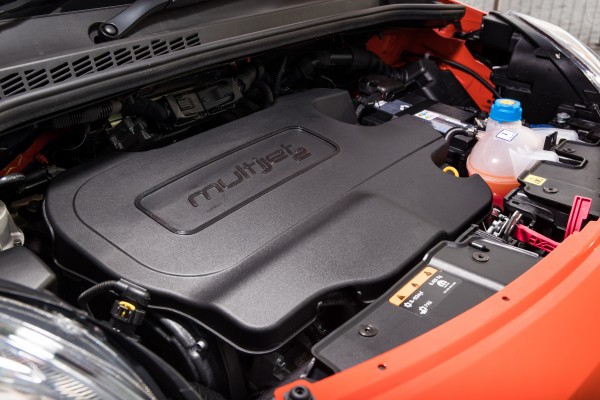
What’s it like to drive?
The 500L’s chassis is a curious beast that really doesn’t do anything well. For a family car, you’d hope for a soft ride that keeps all occupants cossetted and comfortable – but the 500L is almost uncomfortably firm, crashing over speed bumps and potholes and fidgeting on the motorway.
Unfortunately, this doesn’t trade off for sporty handling. The big Fiat still leans like a ship in corners and its skinny front tyres don’t inspire huge amounts of grip.
That’s not helped by the steering which is over-light and totally devoid of feel. You can make it lighter still with the ‘City’ button on the dashboard, but we’d advise against using this as it feels totally unnatural.
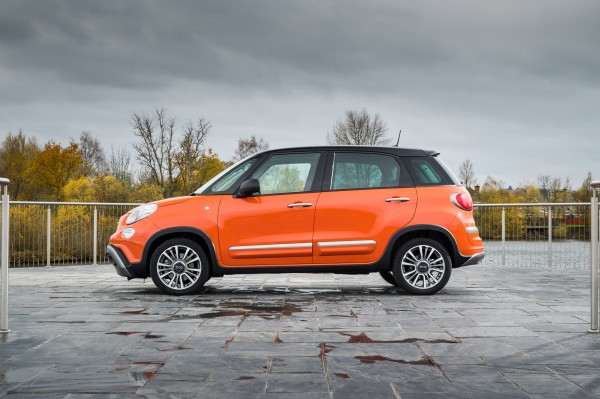
How does it look?
Fiat has done its best to translate the 500’s quirky styling onto the 500L, and it’s succeeded to a point. It’s very definitely a member of the 500 family, with the chromed ‘mustache’ and big, rounded headlights. But the bulbous body and bloated proportions mean it errs on the side of ugly, though its distinctive look may appeal to some.
There are two ‘flavours’ of 500L – Urban and Cross. Each takes inspiration from different ends of the 500 range. The Urban matches up with the 500 hatch – featuring copious amounts of chrome and body-coloured mouldings.
The Cross joins the 500X at the rugged end. Shiny chrome has been given a dark satin finish and there are black plastic mouldings around the wheelarches, to give better protection against shopping trolleys in supermarket car parks.
Cross models also gain distinctive skid plates front and rear and a rectangular motif in the front grille.
What’s it like inside?
The 500L’s interior only really lacks one thing – colour. A sea of grey plastic, it completely ruins any cutesy image Fiat may have been attempting to convey, and makes the interior feel dark and depressing, even when fitted with the panoramic glass roof.
Quality isn’t all there, either. Though the facelift has improved the touch points – the steering wheel and gearshift both feel great – it’s done nothing for the scores of scratchy plastics covering the lower half of the dash.
That boxy shape may look frumpy from the outside, but it pays dividends when it comes to interior space. The 500L offers far more passenger and luggage room than any similarly-sized ‘family’ crossover, along with a healthy chunk of versatility. The rear seats are capacious, and can be slid backwards and forwards to maximize boot space or leg room as you see fit. However, the glass roof severely impacts headroom – even tall children will find themselves squashed.
They can also fold flat or tumble forward, making the load space impressively versatile – aided by a big boot opening and square shape.
Passengers will also enjoy the view out. Visibility is excellent, with an enormous panoramic windscreen and massive front quarterlights. The windowline also stays low, rather than ‘kicking up’ at the rear of the vehicle – improving the view for kids and hopefully reducing car sickness.
Oddly, rear seat passengers are better catered for than those in the front. The funky front seats aren’t very comfortable, and feel like they’re positioned too close together – burly drivers will be bumping elbows with their passengers.
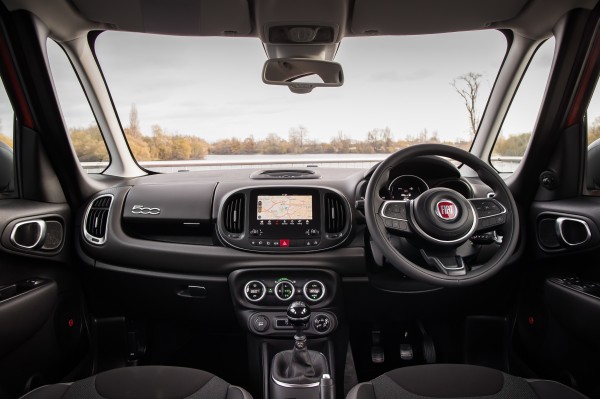
What’s the spec like?
For the price, the 500L actually comes decently equipped. Urban models are available in Pop Star or Lounge trims, and all come with air conditioning, cruise control, electric mirrors, USB, Bluetooth and aux-in for the stereo, LED running lights and 16-inch alloy wheels. Lounge adds dual-zone climate control, a panoramic glass roof, foglights, DAB, rear parking sensors and a height adjustable load floor.
Cross models get a couple of off-road-biased extras. Traction+ is no substitute for a full four-wheel-drive system, but should help on a muddy track or wet field. It shunts the power to whichever front wheel has the most grip. There’s also the brilliantly named Gravity Control, which is Fiat slang for hill descent control.
Base-spec cars get a five-inch Uconnect touchscreen, which is really far too small to be used comfortably. Even the larger seven-inch unit looks desperately lost in the vast expanse of the 500’s dash. It’s also slow to respond and has a low resolution.
Value is a trump card, though, as the 500L’s price list doesn’t look too different to that of many superminis. A basic Pop Star with the 95bhp petrol engine comes in at £16,195, while even a top-spec diesel Lounge Wagon is only £22,320.
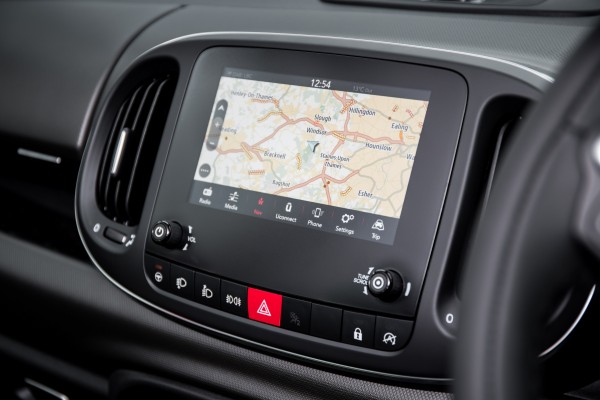
Verdict
The 500L remains a quirky and eye-catching way to move your family about, with a very practical interior that puts many a similarly-sized SUV to shame. Unfortunately, it’s crippled in just about every other area, lacking the charm of its smaller sibling and with a driving experience on the wrong side of inoffensive. Young families after a stylish family bus could find the 500L an appealing choice over a crossover, but when the kids grow up, it might be time to retire from the 500 brand.

FACTS AT A GLANCE
Model: Fiat 500L
Price as tested: £20,820
Engine: 1.6-litre four-cylinder turbodiesel
Power (bhp): 118
Torque (Nm): 320
Max speed (mph): 117
0-60mph: 10.5 seconds
MPG (combined): 67.3
Emissions (g/km): 112





